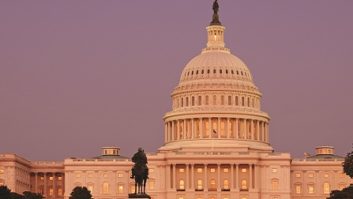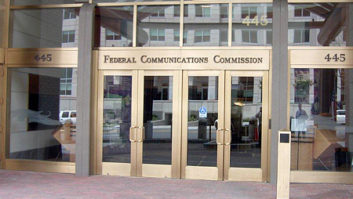WASHINGTON Amid extraordinary security restrictions that presented technical challenges, major radio news networks covered the Jan. 20 swearing-in of President Barack Obama. Coverage of the historic presidential inauguration included reports from the West Front steps of the U.S. Capitol and from along the parade route to the White House.
Historians say the first presidential inauguration broadcast on radio was that of Calvin Coolidge in 1925. More than 80 years later, despite so many more available media options, radio seems to still play an important role.
Radio broadcasters say there were plenty of technical challenges involved. In some cases, recent technology allowed the radio nets to cover more events at less cost, such as using IP codecs and mobile broadband, thus eliminating the need for tapping copper phone lines. Some coverage highlights:
American Urban Radio Networks (AURN):
The radio network, comprising the Sheridan Broadcasting Network and American Urban Network, has covered presidential inaugurations before. However, inauguration of the first black president was especially exciting for the network’s core listeners, said Tene` Croom, news director for AURN.
AURN launched long-form programming an hour before the swearing-in, with Croom co-hosting from the network’s Pittsburgh operations center with Joe Mistick, a Duquesne University law professor. Washington Bureau Chief April Ryan roamed the two-mile long National Mall filing reports recorded on a Marantz PMD560 flash drive recorder and edited on her laptop.

Aaron Katersky and Vic Ratner anchoring ABC News Radio’s inauguration day coverage. “Cell service was very sketchy throughout the day, but April did use her cell phone for live reports,” Croom said.
Croom and Mistick watched the ceremony on TV in their Pittsburgh radio studio, which allowed them to call the “play-by-play” of the inauguration. AURN also used AP Radio audio for pool coverage of the opening ceremonies and the actual swearing-in.
“We also supplemented our coverage with a number of interviews with members of the Congressional Black Caucus, which represents African-American members of the United States Congress and others from the civil rights arena,” Croom said.
ABC News Radio:
Pretty much a full day of long-form coverage led by anchors Aaron Katersky and Vic Ratner highlighted ABC News Radio’s inauguration day coverage. The network embraced new technology to extend coverage into areas where POTS phone terminals were unavailable, including the use of IP codecs and satellite phones.
“We used a mix of IP codecs and traditional wired codecs throughout the day. We utilized Comrex, Telos and Tieline units with ISDN positions at the Capitol. We were worried about using wireless technology around the Capitol,” said Jeff Fitzgerald, executive director operations for ABC News Radio. “The key to our planning was to use some land-based phone technology where available, but supplement with IP codecs depending on the situation.
“We had multiple telco paths set up at the Capitol, from ISDN to POTS phone lines. We also had access to some permanent telco loops extended from our facilities inside the Capitol.”
On the parade route along Pennsylvania Avenue, some ABC radio correspondents used Comrex Access IP codecs, which can access wide-area wireless Internet connections via a cell phone company’s wireless air card or data card, Fitzgerald said.
ABC News Radio had seven operations people on hand to help with the day’s coverage, Fitzgerald said, including one engineer on a flatbed truck directly in front of the president’s limo in the parade.
But adding to the list of broadcast options for ABC News Radio was an older form of channel: its Marti capability. The radio network has receiver locations strategically placed across the city, Fitzgerald said.

By some estimates, 2 million people squeezed onto and around the National Mall to see the swearing-in. Photo by Paul McLane “It’s a nice luxury to have. It makes us a bit more mobile,” Fitzgerald said.
Thrane & Thrane Explorer satellite phones, capable of placing calls of up to 64 kpbs, which are ISDN quality, rounded out ABC’s arsenal of audio sources.
“We anticipate production costs for these types of events to go down, outside of the initial capital costs, with the use of IP codecs. As the wireless infrastructure in this country gets to G4, whether is it’s WiMax or whatever, and it becomes much more widespread, there will be no need for ISDN copper wire connections,” Fitzgerald said.
Fitzgerald said ABC News Radio pre-set all of its equipment before the Secret Service security sweep in the early morning hours of Inauguration Day.
National Public Radio:
Covering a presidential inaugural is a “technical feat” that compares to nothing else, said Charlie Mayer, operations manager for NPR.
“Not even the political conventions stack up against all of the inauguration hoopla. At least at the conventions, everything is confined to a single venue. Inaugural coverage is spread out over so many locations that it starts to spread your resources thin. It was probably the most complicated day of broadcasting NPR has ever done.”
NPR worked closely with Verizon to find copper wiring already in place along the mall for several ISDN locations, Mayer said. In fact, NPR tapped some copper phone pairs left over from a Britney Spears concert in 2003 that was part of a kick-off event for the National Football League season that year.
Mayer said a lack of power at several remote locations prompted NPR engineers to use 12V battery operated Tieline Commander G3 ISDN units. To measure what the battery life would be in the biting cold, engineers concocted a test in which they placed the batteries in a freezer to determine how long their ISDN units would remain powered (see sidebar).
Redundancy is important for any live broadcast application and NPR took every precaution to ensure a smooth on-air presentation, Mayer said.
“We had two ISDN lines and two codecs at our four most important locations. And we had POTS lines at all locations. We mitigate the risks of equipment failure by assigning excellent technicians,” Mayer said.
NPR had six field engineers on the ground Inauguration Day; they began setting at 4 a.m.
Producers and engineers on the ground often used peer-to-peer or PIN messaging between Blackberries for two-way communication, Mayer said.
“It was much more reliable than texting and certainly regular cell phone service.”
NPR News, which drove vans equipped with Secret Service vehicle permits to access remote locations in the early morning of Inauguration Day, offered six hours of special broadcast and Webcast coverage. The Public Broadcasting Service had reporters positioned at dozens of locations along the parade route, including the Canadian Embassy and Freedom Plaza. Steve Inskeep and Michele Norris anchored coverage from the West Front of the Capitol.
CBS Radio News:
NPR Devises Power Consumption Test

To simulate the affects of cold weather on battery packs to power their Tieline Commander G3 ISDN units, NPR technicians froze a Panasonic Lead Acid LC-R127R2P battery. Photo by Chris Nelson, NPR
Techies Freeze Battery, Chill Codec to Replicate Conditions
Curious about the affects of cold weather on battery packs that would power their Tieline Commander G3 ISDN units, NPR technicians simulated the expected cold of Inauguration Day by taking a Panasonic Lead Acid LC-R127R2P battery and freezing it in a GE Refrigerator/Freezer combo in the break room at NPR’s Washington headquarters.
After several hours at 11 degrees Fahrenheit, NPR engineers connected the frozen battery to a Tieline codec that had been chilled to 38 degrees in the combo’s refrigerator.
“We purposely connected two microphones and two pairs of headphones with the volume all the way up to accurately simulate the power consumption we expected on Inauguration Day,” said Chris Nelson, NPR technical director.
In the test conditions, the Tieline remained powered for approximately 4.5 hours, Nelson said.
“Other than one of our Tielines smelling a bit like tuna fish after emerging from the fridge, it was a good result for us,” Nelson said with a chuckle.
NPR then used Keeper Thermal Bags to insulate their equipment from bitter January temperatures. By placing batteries and ISDN codecs inside the bags, engineers figured their own self-generated heat would keep the gear reasonably warm. Hand-warmers were kept at the ready if needed, Nelson said.
“The thermal bags were a big success. And it turned out they served dual purposes,” Nelson said. “Shortly after the conclusion of the swearing-in at the Capitol, there was a mad scramble by hundreds of thousands of people along the National Mall who were headed for the parade route, for their busses, or just some place to warm up.
“This caused a huge dust cloud to erupt along the pathways on the mall, quite close to our ISDN stations. Our reporters, headphones and microphones were covered in sandy, dusty filth, but the Tieline codecs inside were protected from the unexpected storm.”
— Randy J. StinePlanning for live anchored coverage of Obama’s inauguration began immediately after the election, said Craig Swagler, executive producer of special events for CBS Radio News.
“We started with a footprint of what we wanted to do and then built the technical part to fit it. This was certainly historic. We wanted to bring the highest quality audio we could do for this event.”
Covering the inaugural is like planning a “multitude of mini-remotes all over town” at the same time, Swagler said.
CBS Radio News, which four tech staffers on the ground the day of the inauguration, focused this year on using as many Web-based IP codecs as possible; the codecs were connected to terrestrial Internet connections, mostly DSL lines, Swagler said.
“We did use a hodgepodge of things — everything from POTS line Comrex, regular ISDN and the new IP codecs. No cell phones though. We figured those wouldn’t work with so many people taxing the cellular spectrum.”
Setup began five days prior, Swagler said, with special site access thanks to Capitol Police.
Swagler said his technical staff always brings extra gear, including ISDN and Comrex Hotlines, in case of equipment failure.
“We also order extra ISDN circuits from the phone company in the event one goes bad during the event,” Swagler added.
Dan Raviv hosted CBS Radio News’ inaugural long-form programming. Correspondents Peter Maer, Bob Fuss, Mark Knoller and Tom Foty were among those who contributed from locations around the city. Most carried Marantz PMD620 recorders for audio gathering.
CBS Radio News made the special reports available to affiliate stations for Webcasting and podcasting.
Radio One:
This radio broadcast group, which owns 53 radio stations in 16 urban markets and is based in nearby Maryland, made its presence known.
“This was huge for us. We had five of our syndicated morning shows doing their shows live from the JW Marriott hotel on Pennsylvania Avenue, which is of course right along the parade route,” said Scott Tanner, engineering manager for Radio One’s Washington cluster.
Radio One partnered with The Stafford Foundation, a faith-based non-profit group, to convert open space to radio studios on the 12th floor terrace overlooking Pennsylvania Avenue. Onsite broadcasts included the “Rickey Smiley Show,” “The Russ Parr Show,” “The Yolanda Adams Morning Show” and Sybil Wilkes from the “Tom Joyner Show.”
“This was major complicated from start to finish. The key was that no one listening knew it was complicated,” Tanner said.
Radio One used POTS ISDN lines at the JW Marriott with JK Audio boxes for basic mic and headset hookups, Tanner said.
Preparations included organizing every piece of remote equipment in a conference room at Radio One’s Lanham headquarters. Tanner said he labeled the gear and pre-wired everything he could and packed the gear into cases and labeled them.
“Pre-planning, pre-testing and pre-set up was key for us,” Tanner said.
In addition to the morning broadcasts, Radio One positioned two reporters at the Capitol building for updates. It also made audio of the swearing-in ceremony available to its stations.









